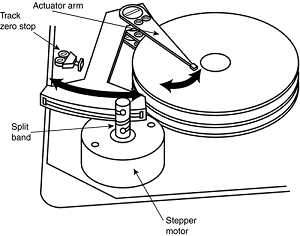Hardisk Head Actuator Mechanisms
Possibly more important than the heads themselves is the mechanical system that moves them: the head actuator. This mechanism moves the heads across the disk and positions them accurately above the desired cylinder. Many variations on head actuator mechanisms are in use, but all fall into one of two basic categories:
-
Stepper motor actuators
-
Voice coil actuators
The use of one or the other type of actuator has profound effects on a drive's performance and reliability. The effects are not limited to speed; they also include accuracy, sensitivity to temperature, position, vibration, and overall reliability.
The head actuator is the single most important specification in the drive, and the type of head actuator mechanism in a drive tells you a great deal about the drive's performance and reliability characteristics.
Stepper motor actuators were commonly used on hard drives made during the 1980s and early 1990s with capacities of 100MB or less. All the drives I've seen with greater storage capacity use a voice coil actuator. Floppy disk drives position their heads by using a stepper motor actuator.
The accuracy of the stepper mechanism is suited to a floppy disk drive because the track densities usually are nowhere near those of a hard disk. The track density of a 1.44MB floppy disk is 135 tracks per inch, whereas hard disk drives have densities of more than 5,000 tracks per inch.
All hard disk drives being manufactured today use voice coil actuators because stepper motors can't achieve the degree of accuracy necessary.
Stepper Motor Actuators
A stepper motor is an electrical motor that can "step," or move from position to position, with mechanical detents or click-stop positions. If you were to grip the spindle of one of these motors and spin it manually, you would hear a clicking or buzzing sound as the motor passed each detent position with a soft click.
Stepper motors can't position themselves between step positions; they can stop only at the predetermined detent positions. The motors are small (between 1'' and 3'') and can be square, cylindrical, or flat. Stepper motors are outside the sealed HDA, although the spindle of the motor penetrates the HDA through a sealed hole.
Stepper motor mechanisms are affected by a variety of problems, but the greatest problem is temperature. As the drive platters heat and cool, they expand and contract, and the tracks on the platters move in relation to a predetermined track position.
The stepper mechanism can't move in increments of less than a single track to correct for these temperature-induced errors. The drive positions the heads to a particular cylinder according to a predetermined number of steps from the stepper motor, with no room for nuance.
Figure below shows a common stepper motor design, in which a split metal band is used to transfer the movement from the rotating motor shaft to the head actuator itself.

Voice Coil Actuators
The voice coil actuators used in virtually all hard disk drives made today—unlike stepper motor actuators—use a feedback signal from the drive to accurately determine the head positions and adjust them, if necessary. This arrangement provides significantly greater performance, accuracy, and reliability than traditional stepper motor actuator designs.
A voice coil actuator works by pure electromagnetic force. The construction of the mechanism is similar to that of a typical audio speaker, from which the term voice coil is derived. An audio speaker uses a stationary magnet surrounded by a voice coil, which is connected to the speaker's paper cone.
Energizing the coil causes it to move relative to the stationary magnet, which produces sound from the cone. In a typical hard disk drive's voice coil system, the electromagnetic coil is attached to the end of the head rack and placed near a stationary magnet.
No physical contact occurs between the coil and the magnet; instead, the coil moves by pure magnetic force. As the electromagnetic coils are energized, they attract or repulse the stationary magnet and move the head rack. Systems like these are extremely quick, efficient, and usually much quieter than systems driven by stepper motors.
Unlike a stepper motor, a voice coil actuator has no click-stops or detent positions; rather, a special guidance system stops the head rack above a particular cylinder. Because it has no detents, the voice coil actuator can slide the heads in and out smoothly to any position desired.
Voice coil actuators use a guidance mechanism called a servo to tell the actuator where the heads are in relation to the cylinders and to place the heads accurately at the desired positions. This positioning system often is called a closed loop feedback mechanism.
It works by sending the index (or servo) signal to the positioning electronics, which return a feedback signal that is used to position the heads accurately. The system also is called servo-controlled, which refers to the index or servo information that is used to dictate or control head-positioning accuracy.
A voice coil actuator with servo control is not affected by temperature changes, as a stepper motor is. When temperature changes cause the disk platters to expand or contract, the voice coil system compensates automatically because it never positions the heads in predetermined track positions.
Rather, the voice coil system searches for the specific track, guided by the prewritten servo information, and then positions the head rack precisely above the desired track, wherever it happens to be. Because of the continuous feedback of servo information, the heads adjust to the current position of the track at all times.
For example, as a drive warms up and the platters expand, the servo information enables the heads to "follow" the track. As a result, a voice coil actuator is sometimes called a track following system.
The two main types of voice-coil positioner mechanisms are
-
Linear voice-coil actuators
-
Rotary voice-coil actuators
The two types differ only in the physical arrangement of the magnets and coils.